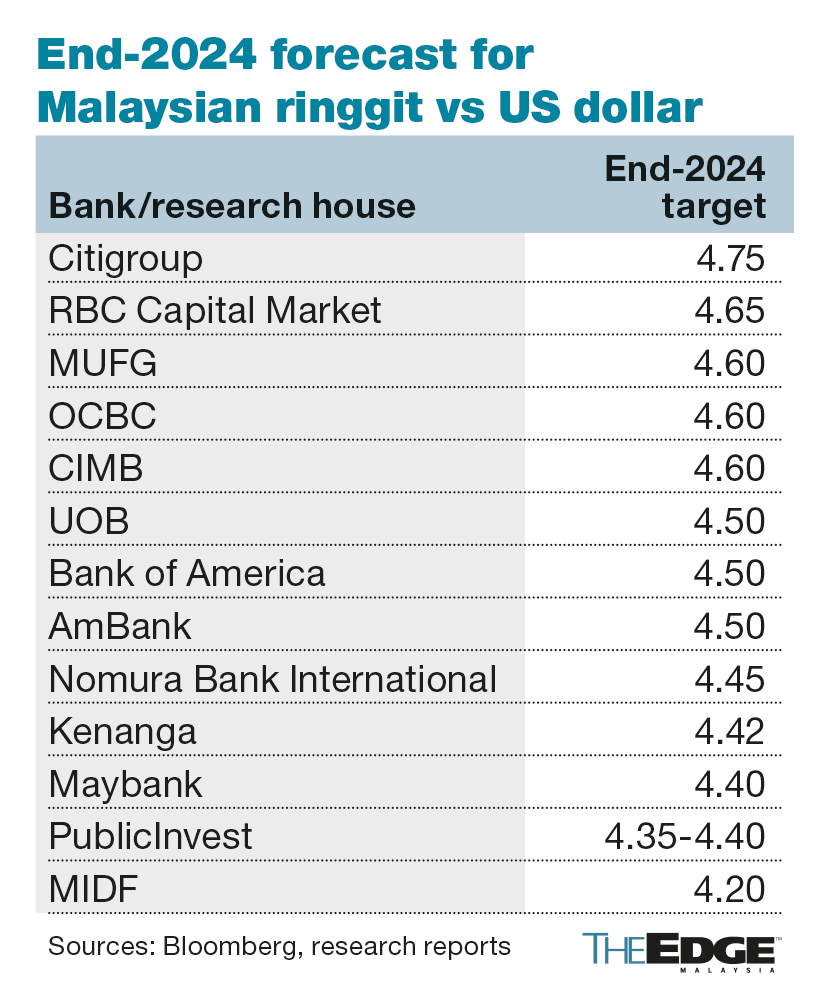
KUALA LUMPUR (Feb 20): The ringgit’s current level does not reflect the positive outlook of the Malaysian economy, the central bank said on Tuesday, as the currency dropped to its lowest against the US dollar since 1998 and hit a fresh record low against the Singapore dollar.
Bank Negara Malaysia (BNM) governor Datuk Abdul Rasheed Ghaffour said the recent performance of the ringgit is similar to other regional currencies, in that they have been influenced by external factors.
"Some of these factors include market adjustment to changing US interest rate expectations, geopolitical concerns and uncertainty surrounding China’s economic prospects," he said in a statement addressing the issue.
The ringgit reached its 26-year low of 4.800 against the US dollar on Tuesday, a range last seen in 1998 at the peak of the Asian financial crisis, when it touched a record low of 4.885 against the greenback on Jan 7 that year.
At the time of writing, the ringgit has pared some of its losses to trade at 4.799 per US dollar, tracking other emerging Asian currencies which also weakened against the US dollar.
Year to date, the ringgit has fallen close to 4% against the US dollar so far. Over the past one year, the ringgit has fallen against most major regional currencies, save for the Japanese yen. Against the Singapore dollar, the ringgit skidded to its new record low of 3.5683, where it was hovering at press time.
Abdul Rasheed went on to assure that Malaysia's economic growth in 2024 will be driven by improvements in external demand and strong domestic spending. He also pointed to the latest global trade growth forecast from the International Monetary Fund (IMF) of 3.3% in 2024 as opposed to 0.4% in 2023.
"For Malaysia, exports have shown steady improvements since the fourth quarter of 2023. In fact, the recently-released January 2024 exports have turned positive (up 8.7%). The tourism sector has recovered strongly with tourist arrivals in 2024 expected to exceed the pre-pandemic levels of 26 million. Investment momentum has picked up with the implementation of approved projects both in the private and public sectors," he noted.
"Reflecting these positive developments and the government’s commitment to implement structural reforms and the expected lowering of interest rates in advanced economies, most analysts are forecasting for the ringgit to appreciate this year," he added.
When asked by Bernama if there is a need to peg the ringgit against the US dollar, Finance Minister II Datuk Seri Amir Hamzah Azizan on Monday said the current situation is very different compared to the Asian financial crisis of 1998.
"When Malaysia pegged the ringgit against the US dollar in 1998, it was reacting to a very different scenario out there and [within] a very different financial capacity of the country at the time. Today, when we look at the national reserves, debt exposure and financial liquidity in the market, Malaysia does not need to peg its currency," he maintained.
At the height of the Asian Financial Crisis in 1998, BNM pegged the value of the ringgit at 3.80 to the US dollar in an effort to isolate the Malaysian economy from the financial instability sweeping over the region at the time.
Slower-than-expected US rate cuts, weakening renminbi to watch
Forecasts for the ringgit versus the US dollar range from 4.20 to as weak as 4.75 by the end 2024, according to economists estimates compiled by The Edge. Median forecasts for the currency for 2024 stood at 4.50, before strengthening to 4.35 by end-2025, according to forecasts compiled by Bloomberg.
MIDF Research, which is expecting the ringgit to recover to 4.20 against the US dollar by year end, sees a narrowing rate differentials — the US Federal Reserve are expected to cut rates this year — to contribute to the reversal of funds back into emerging markets and Malaysia.
"On the other hand, several factors could weigh down on ringgit performance such as possible recession risk in the US, and continued weakness in global trade and manufacturing activities," the research house said in a January report.
The longer it takes for the spread between US and Malaysia's benchmark interest rates to narrow, "the worse it is for the ringgit," a banker told The Edge. Malaysia's overnight policy rate currently stands at 3%, while the US Fed funds rate is at 5.5%.
Aside from persistent inflation in the US that could slow rate cuts there, market watchers are also keeping an eye on the weakening Chinese renminbi, which affects the competitiveness of exports of Southeast Asian countries like Malaysia — making the weak ringgit less beneficial, the banker said.
"It is important that the tens of billions of FDIs under recent MOUs to materialise" to support the local currency, he added.
- US seeks to control Ukraine investment, squeezing out Europe
- US beef sales to China skid after Beijing lets export registrations lapse
- HI Mobility debuts on Main Market with slight premium
- Iran oil-filled tankers build up off Malaysia as US sanctions mount
- Cars under US$30,000 risk becoming a casualty of Trump’s tariffs
- Stocks with momentum on March 28, 2025: GDEX, Pecca Group
- Selangor fibreglass plastic maker WF Holding breaks below IPO price on Nasdaq listing day
- US Vice President Vance to visit Greenland, the island Trump wants to control
- Putin says rivalries are increasing in the Arctic, but Greenland situation has 'nothing to do' with Russia
- BOJ set for rate hikes as Tokyo inflation exceeds forecasts





